Adriana Varejão (Brazil, 1964) articulates the arts: painting, sculpture, photography or architecture with a contemporary baroque style. Beneath a complex conceptual process lie principles such as identity, assimilation, anthropology, the body… stemming from her deep-rooted historical and cultural heritage. The three centuries of Portuguese colonization are reflected in her works by way of mosaic tiles, water or flesh, with references made to the primitive history and the indigenous identity of her country; as well as in the excess, the monumentality, the dramatic esthetics displayed in her penchant for the baroque. An art full of symbolism, of the bends and folds so typical of the esthetics of the period. At the same time, bodies that are objectified and then desecrated. Destruction and annihilation in the colonization process, but also assimilation and the creation of new values, in step with nature.
Author: Elena Cué
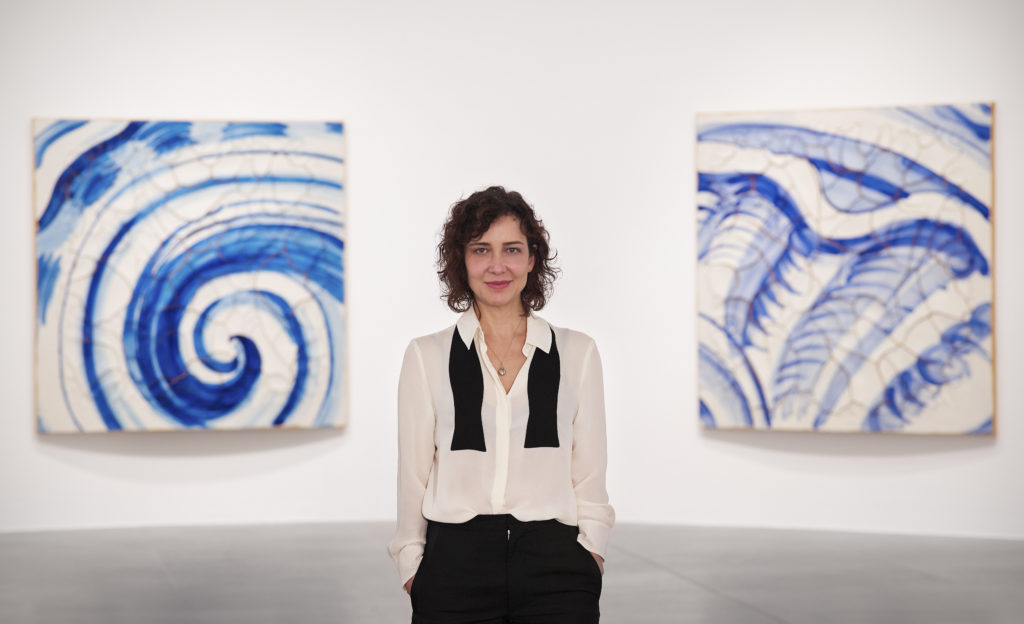
Portrait of Adriana Varejão. Photo by: Matteo D’Eletto M3 Studio © Gagosian and the artist.
Adriana Varejão (Brazil, 1964) articulates the arts: painting, sculpture, photography or architecture with a contemporary baroque style. Beneath a complex conceptual process lie principles such as identity, assimilation, anthropology, the body… stemming from her deep-rooted historical and cultural heritage. The three centuries of Portuguese colonization are reflected in her works by way of mosaic tiles, water or flesh, with references made to the primitive history and the indigenous identity of her country; as well as in the excess, the monumentality, the dramatic esthetics displayed in her penchant for the baroque. An art full of symbolism, of the bends and folds so typical of the esthetics of the period. At the same time, bodies that are objectified and then desecrated. Destruction and annihilation in the colonization process, but also assimilation and the creation of new values, in step with nature. Sensuality and eroticism emerge as a clear oriental allusion to round off the work of this artist.
She has just opened, for the first time in Rome, two large exhibits: the first, Adriana Varejão: Azulejão in the Gagosian Gallery, and the second, Transbarroco in the Villa Medici. These have been the initial focus point of our conversation on the sources of her artistic inspiration.
What authors have enriched your thought and your work?
The Cuban writer Severo Sarduy has been very influential on my work, because he thought about the Baroque from a very dense perspective. There are two books that were important Written on the Body and The Baroque. As a Cuban, his perspective was distinct from the Europeans. Together with Jose Lezama Lima and Octavio Paz, his writing was very important in the beginning to help me build my intellectual framework. A bit later, in the nineties, I read the historian Sergio Buarque de Hollanda's book Visions of Paradise, and Gilberto Freyre's Casa Grande Senzala. With these two books, my perspective on history began to form in my work. In recent years, I have been working actively with the work of contemporary historians such as Carlo Ginzburg and Giovanni Levi and in Brasil with Lilia Moritz Schwartz, Antonio Risério, and anthropology Eduardo Viveiros de Castro.
Continuing with the Brazilian society, What do you think of the current artistic scenography in Brazil?
I think that Brazil is a failed project as a country, socially, politically and economically. But in terms of its cultural identity, it is very potent because of the huge richness and variety of languages that is the result of miscegenation. It has so much to show to the rest of the world.
When did you realize you would like to be an artist? And, how was this process?
Decisions in life do not happen just like that. Every child begins by making art and experimenting. As they grow, some people then lose the ability and conform to other expectations. Let's just say that I became involved, inextricably, and it is a process of constant renewal, up until today.
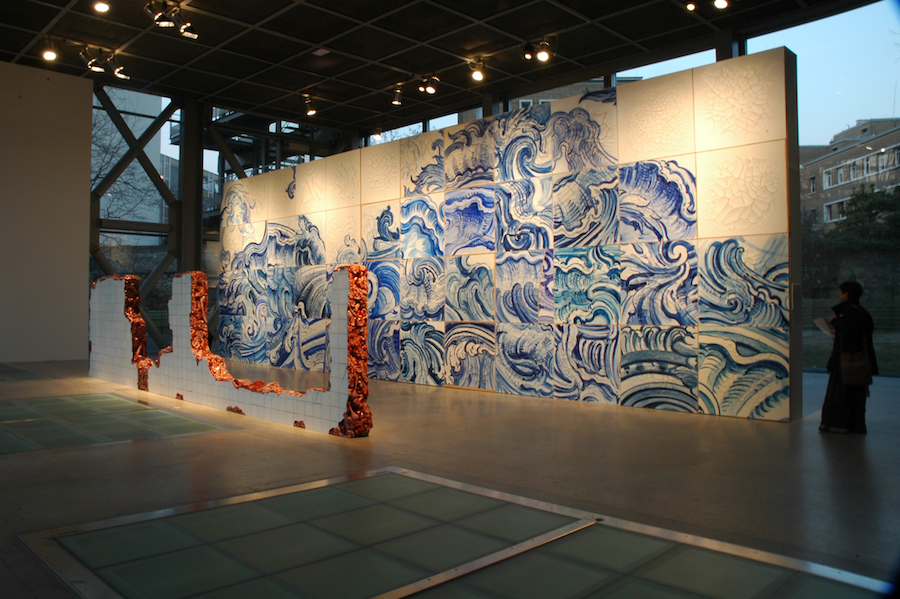
Installation view, Fondation Cartier, Paris. © Adriana Varejão. Photo by Vicente de Mello. Courtesy Gagosian Gallery.
In your series Tongue and incisions (walls with incisions through which entrails sprout out), the inorganic matter of the tiles is joined together with the organic matter of the viscera. Where does this need come from?
I wanted to combine the rational grid of the tiles with the erotic nature of meat, all simulated within the artificial and voluptuous language of the Baroque. The tiles are not tiles and the meat is not meat.
You convert the object into something transcendental when you add entrails, our most inner and private parts, only to later tear it up. What enigma hides behind these pieces?
It's to reveal a body behind the layers. When I am dealing with "history", I am dealing with history imprinted or inscribed on bodies, private, fluid, and individual -- which is very different from the official versions of world history.
That meat is like a violent explosion. Does it comprise any sort of love or sacrifice?
Yes. I am engaged with the history of art not reality. Painting meat and flesh belongs to a very, very old tradition in painting -- pintura de bodegon and the Baroque tradition that exposes the body through wounds, and for which the bleeding anatomical heart is the emblem. Think of Goya, Rembrandt, Gericault, Soutine, Bacon, and then, of course, Paul Thek, who worked in three dimensions with his modernist "reliquaries."
There is an Eastern penchant that is reflected in references to the great Wave of Kanagawa, landscapes and eroticism... What sort of interest do you have in this culture?
I am dealing with parody, not with real history. And in doing so, I am addressing the migration of images, from Portugal to Brazil via Asia, which you can find, for example, in the interior decoration of Baroque churches in Brazil.
Related to the Azueljao paintings, I also studied Chinese Song pottery of the eleventh century. I became deeply fascinated by its characteristic surface cracks and its attendant philosophy. It is in these cracks that Chinese writing actually originates. An entire aesthetic evolved from reading meaning into cracks, slowly becoming its own culture.
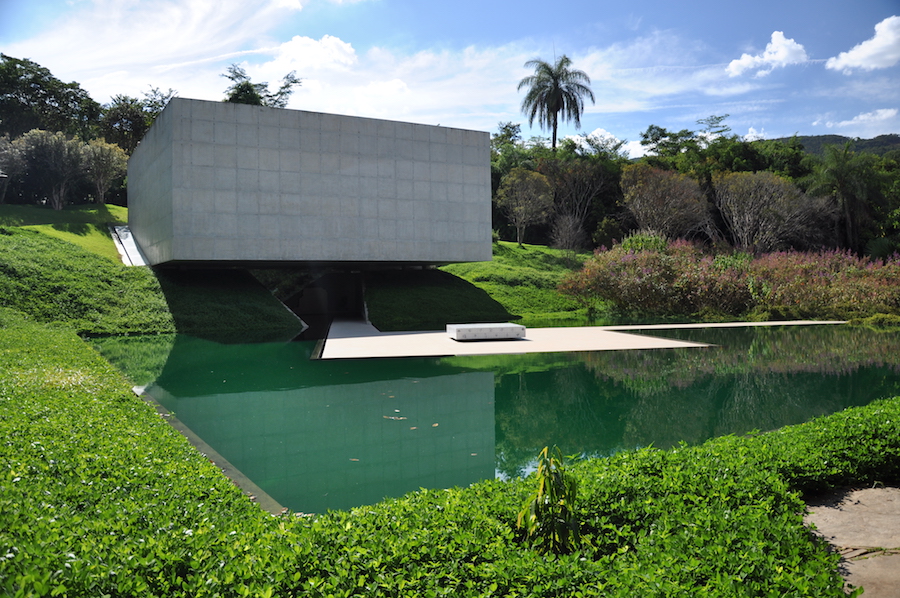
Adriana Varejão, Panacea Phantastica, 2003 – 2008, at Inhotim, Brazil
Please tell me about your installation at Inhotim in Belo Horizonte, Brazil, where all of the arts come together as a total work.
Much of my work is inspired by the traditional Portuguese azulejo, which were traditionally used to decorate architecture. My Inhotim project is a modern architectural cube that is penetrated by water, terraces, staircases. I made a container with an inner skin of tile paintings, sculptures that relate to architecture, and real tiles incorporated into built-in architectural furniture.
Thermal baths, pools, tiles and water. Once again, we see the organic and the inorganic in your iconography. Sometimes there are ripples of violence in your portrayal of water. In your work, what is the meaning of the connection between violence and water?
It is only fiction; the inference of violence gives some drama to these scenes. In the sauna paintings, I deal with very classical topics of painting -- paint, color, tone, perspective, and so on. They also reflect the erotic literature that I was reading at the time -- Georges Bataille and the Marquis de Sade. I gave these paintings titles like The Collector, The Seducer, and so on. There is an ambiguous atmosphere, a suspended narrative in these paintings. When I was working on them it was much more about painting than telling stories.
Some of your works display the prevalence of violence, the violation of limits, both sexual and in the form of the abuse of the body, sacrifice and death. What is behind this tendency for such extreme life situations?
To elaborate on what I said earlier, art is an experimental universe where everything can be played at the edge. That is the role of art. I explore violence in many forms in art, not in life. Just as de Sade attacked language not the body itself, acting symbolically.
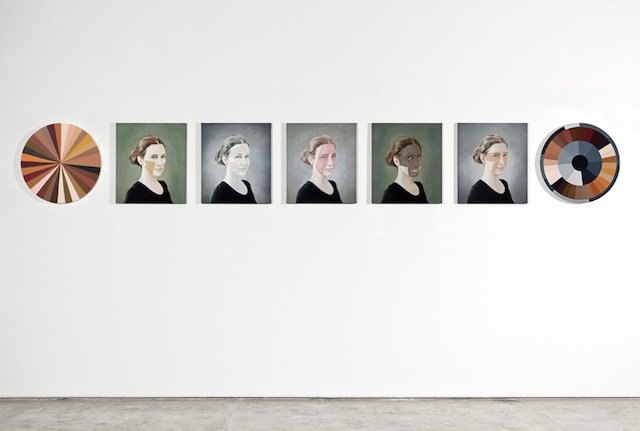
Adriana Varejão’s series Polvo. Image courtesy of ICA Boston
In your series Polvo –a set of self portraits-, the central focus actually resides in the changes in your skin colour. What message are you conveying about the racial and cultural identity of Brazil?
This is about the mestizo identity of Brazil, which is nothing to do with the polar opposites of black or white, but with all the many shades and subtleties and variations in between. Polvo is a paintbox where the names of the paints reveal that every definition is about language, like "Almost White." I started thinking about the idea of "flesh tone" and what it means in different cultures, but in the beginning I could only find a pink color in all of the oil-paint brands that I was collecting all over the world. So, I decide to develop a conceptual brand "Polvo", that reveals the complexity and variety of the subject. Color is a language subject.
And what is the relationship between identity and the portrayal of power and subjugation in your work?
I believe in miscegenation, not the dichotomy of master and slave. Brazil evolved as a country with a cultural (mestizo) identity that is so strong that it is impossible for any single identity to remain fixed, separate, and intact for more than one generation.
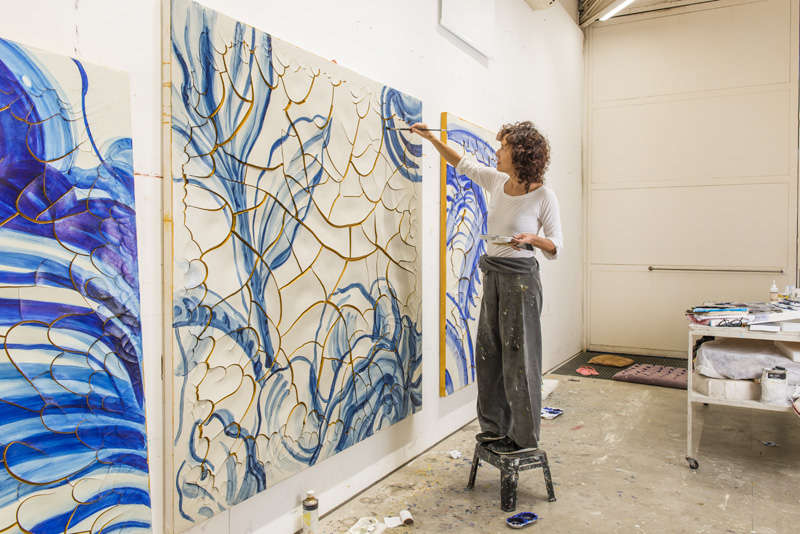
Portrait of © Adriana Varejão. Photo by Vicente de Mello. Courtesy Gagosian Gallery.
Adriana Varejão: “Azulejão” Until December 16, 2016
Gagosian Rome - Via Francesco Crispi 16, Rome

